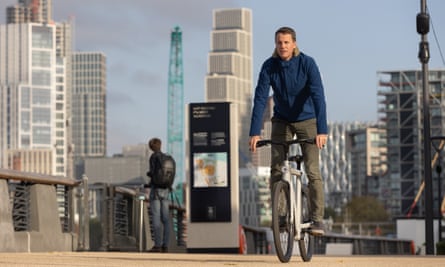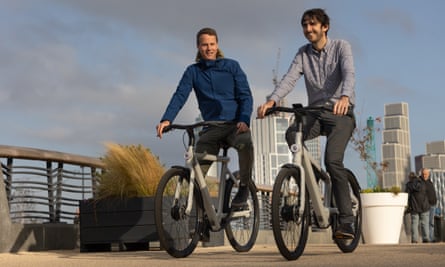The rebuilt Battersea power station in south-west London is an impressive architectural feat: its landmark towers were carefully deconstructed and then rebuilt while the derelict structure beneath was filled with modern conveniences. It has also received its fair share of opprobrium, with critics objecting to the privatisation, monetisation and gentrification the project has entailed.
All of which makes it an apt place to meet Ties Carlier, at the new London store of VanMoof, the e-bike company he founded with his brother in 2009. He, too, is out to reinvent an old classic, building it from the ground up for the modern era, injecting convenience and polish where others prefer the more rustic charm of what came before.
Like normal bicycles, e-bikes still need to be pedalled, but use a battery-powered motor to help the rider achieve speeds up to a UK legal maximum of 15.5mph. Carlier hails from the Netherlands – as his first name, height (he’s 6ft 6in) and the fact that he’s a cycling entrepreneur would suggest – but it was the Big Apple rather than Amsterdam that sparked the creation of his business.
CV
Age 43
Family Lives in Taipei in Taiwan with wife, Cheryl, and two young daughters
Education Car mechanic training in the Netherlands.
Pay “It’s never been that important for me and my brother. Our business is our biggest hobby, so we like to keep as much in the company as we can.”
Last holiday “We’ve been making holidays out of VanMoof store visits. Last year we went to six brand stores in Germany in one week.”
Best advice he’s been given “Stay fearless.”
Phrase he overuses “If it was easy, everyone would do it.”
How he relaxes Being on or near water.
Biggest career mistake “Underestimating how difficult it is to disrupt an established industry. I thought we would build a better bike, and then dominate the industry. But we’re still at the beginning.”
“When my brother and I went to New York, we rode bikes, of course, but we saw that no one else was doing that. And the city was so perfect for it! So we thought, OK … this is a beautiful mission: getting more people to ride bikes will improve cities, but it’s also something we can make a business of.”
Carlier and his brother Taco set out to redesign the pushbike for city commuting. The lights were integrated into the frame, so they couldn’t be forgotten or stolen, and a chain lock retracted inside the bike when not in use. Their new design proved popular, but there was a catch. “We were selling out in New York and Tokyo, but we were selling to people who already love their bike. We couldn’t grow out of the niche.”

Where Amsterdam is small and flat and has a mild climate, their target markets were large, often hilly cities, where very cold winters or scorching summers put all but the most dedicated off cycling. The answer was electricity.
“Those elements are overcome by electric power. And that’s when we realised that this can really enable cycling for everyone in the world – no matter how big your city is, no matter how many hills there are, the bike becomes the perfect, best way of travelling.”
In the six years since its Electrified S bike hit the market, VanMoof has shipped about 150,000 and now employs just under 1,000 people. The design has evolved, too: the latest, the S5, launched in April, costs £2,998, and there is still as three- to four-month wait for delivery.
The company’s expansion has changed Carlier’s life in a more fundamental way, too: he met his wife, Cheryl, on a flight to Taiwan, where the bikes are manufactured, and the couple now live in Taipei with their small children.
But even as he tackles the standard growing pains of a young company – taking $128m of venture capital in 2021 to invest in a production process that aims to one day be capable of churning out as many e-bikes in a month as the company has sold since its founding – Carlier is still focused on addressing the pain points that stop so many from cycling.
VanMoof customers can, for example, pay £550 for its Peace of Mind service: a three-year programme offering free maintenance at its outlets and, more controversially, theft protection. The company promises to recover any stolen bike within two weeks or offer a replacement.

A YouTube series following the work of its “bike hunters” – who occasionally even steal bikes back from the thieves – went viral, but Carlier insists the goal is to make the theft protection unncecessary. VanMoof e-bikes lock solid with the touch of a button, they can be followed with GPS tracking until the battery runs flat, and unless the bike’s owner sends an electronic code to unlock it, it would take a skilled mechanic to even turn the bike into an expensive pedal bike.
“In the beginning, in cities where we are not well known, rates of theft are indeed a bit higher. But in Europe, most bike are stolen by bigger, organised gangs, and these people realise very quickly, ‘Oh, that bike. Don’t steal it because we can’t sell it. We can’t use it.’”
However, although theft isn’t a huge problem for VanMoof bikes, fear of it remains an issue. “People solve theft themselves by buying a cheap bike, because ‘then it won’t get stolen’. But it does get stolen, once or twice, so you buy an even cheaper one. Your riding experience gets worse and worse, so you ride less and less. And on top of that, it’s not good for the environment.”
Not every problem standing in the way of e-bikes is solvable with canny design, but that doesn’t mean Carlier won’t try. The company recently announced the VanMoof V, a chunky e-bike that is mechanically capable of going as fast as 31mph. Speed restrictions mean selling such a bike unlocked would be illegal in the UK, and most of Europe, but Carlier wants to provoke a conversation about whether those limits are always justifiable.
“We do think e-bikes should be faster in certain situations, to allow people to cover bigger distances on the bike,” he says. His example is someone who lives in a suburb, who may be able to cycle perfectly safely at 30mph on wide arterial roads, before being limited to lower speeds when the bike detects that it has crossed into the urban core.
“In a real big picture, by enabling people to travel further by bike, you have fewer cars, and more space for those bikes. If you have something that actually brings you outside really easily and with a lot of fun, we could transform the city as we know it.”
